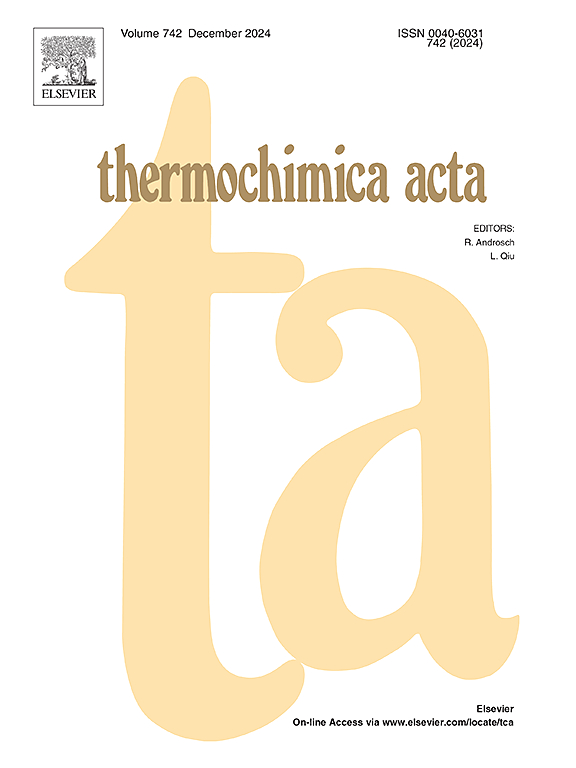KJMA-exponent for the cold crystallization in the stepwise crystallization approach
IF 3.1
2区 化学
Q2 CHEMISTRY, ANALYTICAL
引用次数: 0
Abstract
The stepwise crystallization approach is an extension of the classical Tammann's two stage nuclei development method. In Tammann’s method, crystal nuclei are formed at a given nucleation temperature and are grown up to macroscopic sizes at a higher development temperature. The effects on the number and sizes of the clusters caused by heating from the nucleation to the growth temperature are widely neglected there. The number and sizes of the crystals are typically determined by microscopy. The stepwise crystallization approach employs calorimetry for similar purposes. Instead of the second (development) stage of Tammann's method, stepwise crystallization analyzes the thermal effects evolving during the heating stage. A comparison of the magnitudes of the cold crystallization enthalpy registered during heating of the samples after isothermal (annealing) stage allows estimating the amount of crystal nuclei. Dependence of the magnitude of cold crystallization enthalpy on the annealing time provides in this way information on the nucleation kinetics of the respective material. The parametrization of kinetics is typically performed by fitting experimental data with Kolmogorov-Johnson-Mehl-Avrami type equations. The interpretation of the resulting parameters is not straightforward because the magnitude of cold crystallization effects depends not only on the sample state but also on the heating conditions. Here, the dependence of cold crystallization enthalpy on isothermal (annealing) and heating conditions is treated theoretically to estimate the expected values of model parameters for homogeneous nucleation.
逐步结晶法中冷结晶的kjma指数
逐步结晶法是对经典塔曼两阶段核发育法的扩展。在Tammann的方法中,晶核在给定的成核温度下形成,并在更高的发育温度下长大到宏观尺寸。从成核温度加热到生长温度对团簇数量和大小的影响被广泛忽略。晶体的数量和大小通常是通过显微镜来确定的。逐步结晶法采用量热法用于类似目的。代替Tammann方法的第二(发展)阶段,逐步结晶分析在加热阶段演变的热效应。在等温(退火)阶段后的样品加热过程中记录的冷结晶焓的大小的比较可以估计晶核的数量。冷结晶焓的大小对退火时间的依赖性以这种方式提供了有关各自材料成核动力学的信息。动力学的参数化通常是通过用Kolmogorov-Johnson-Mehl-Avrami型方程拟合实验数据来完成的。对结果参数的解释并不简单,因为冷结晶效应的大小不仅取决于样品状态,还取决于加热条件。这里,从理论上处理冷结晶焓对等温(退火)和加热条件的依赖,以估计均匀成核的模型参数的期望值。
本文章由计算机程序翻译,如有差异,请以英文原文为准。
求助全文
约1分钟内获得全文
求助全文
来源期刊

Thermochimica Acta
化学-分析化学
CiteScore
6.50
自引率
8.60%
发文量
210
审稿时长
40 days
期刊介绍:
Thermochimica Acta publishes original research contributions covering all aspects of thermoanalytical and calorimetric methods and their application to experimental chemistry, physics, biology and engineering. The journal aims to span the whole range from fundamental research to practical application.
The journal focuses on the research that advances physical and analytical science of thermal phenomena. Therefore, the manuscripts are expected to provide important insights into the thermal phenomena studied or to propose significant improvements of analytical or computational techniques employed in thermal studies. Manuscripts that report the results of routine thermal measurements are not suitable for publication in Thermochimica Acta.
The journal particularly welcomes papers from newly emerging areas as well as from the traditional strength areas:
- New and improved instrumentation and methods
- Thermal properties and behavior of materials
- Kinetics of thermally stimulated processes
 求助内容:
求助内容: 应助结果提醒方式:
应助结果提醒方式:


